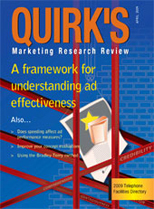Editor's note: This article appeared in the April 20, 2010, edition of Quirk's e-newsletter.
Many business professionals are unknowingly irritating co-workers and clients with bad e-mail etiquette and habits. Even worse, the offenders are tarnishing their reputations in the process, unaware that their e-mails reflect their personal and company brand, image and credibility, according to Jean Kelley's article, "Don't Hit Send! Avoid These Common E-mail Pet Peeves."
Spam for the latest ED drugs, chain letters from old friends, off-color jokes from kooky uncles and pictures of baby animals dressed as humans from your mom - these are just a few things that annoy business professionals when it comes to daily e-mail. While these are the obvious offenders most business professionals know to abstain from, what if your e-mails to colleagues are just as annoying?
Following are the top five e-mail pet peeves in the workplace. Avoid them so your e-mail messages are most effective.
Using poor grammar and spelling. A typo every now and then is not a big deal. However, consistent bad grammar and spelling is obnoxious. E-mail is a form of written communication, so respect the written word. Additionally, this is business, and everything you do, say and write is a reflection of your professionalism. When people read your messages, they naturally and automatically make a judgment about you based on your writing. If your writing is poor, everything else about you is in question. After all, if you don't care enough about your writing, what else don't you care about? Your service? Your customer? Your reader? Gigantic or hard-to-read fonts fall in this category as well. Keep it neat and tidy - sometimes simple can be wonderful. Remember that the written word stays out there forever, and no e-mail message is ever really deleted permanently. Make sure your lasting impressions are good ones.
Using "reply all" vs. "reply." Just because you were one of many recipients on a message does not mean everyone needs to hear your reply. Really think about who needs to see the message. Use the "reply all" button judiciously. And remember that with a "reply all," everyone, even someone who was in the BCC line, will see your comments, so you never really know who is getting your message.
Writing bad subject lines or not using subject lines. Unless you're doing e-mail marketing and relying on your messages to sell people, use straightforward subject lines that reflect the true theme of the message. Resist the urge to be cute and clever. For day-to-day business purposes, plain and direct work best. So rather than have a subject line that reads, "Want to pick your brain," write, "Need your input on the X account."
Realize, too, that many people use their e-mail as a filing system, and they rely on the subject lines to find key information later. So if all your subject lines are vague (as in "A message from Tom Smith" or "Info you requested"), or if you don't use subject lines, people won't know what the message was about when they search their files later. So always write detailed subject lines, as in "Dates for X taste test" or "PowerPoint decks on X qualitative project." And should the e-mail's subject change as the conversation ensues, then change the subject line to reflect the new theme.
E-mailing complicated information. If you have to give someone technical, detailed or complicated information, do it with a phone call and an e-mail as a backup rather than relying solely on the e-mail communication. E-mail is best suited for short messages that don't require a lengthy response. If your e-mail is more than a couple of paragraphs, pick up the phone and talk to the recipient. Use the follow-up e-mail to send needed documentation or a recap of your verbal instructions, but don't expect people to read and act upon a lengthy or complicated message.
Additionally, if you are the recipient of a detailed message and need time to work on the reply, send back a short acknowledgment message that states, "I received your message and am working on the needed items." And if the reply requires real discussion, then pick up the phone and talk about it. Don't rely on e-mail for every topic.
Having sensitive conversations via e-mail. Sensitive and emotionally-charged conversations have no place in an e-mail. If you need to fire someone, express disappointment or apologize, do it face-to-face (most preferred) or via phone. When a topic has emotion behind it, the recipient naturally escalates that emotion when reading the e-mail. Why? Because it's virtually impossible to display emotion in an e-mail (aside from some carefully-placed emoticons, which not everyone appreciates), and humans by nature look for the worst in a message rather than the best.
Adding fuel to the fire is the fact that many people write things in an e-mail that they would never say in person. They view e-mail as a way to have "safe" conflict without being face-to-face. So they may snap back at someone in a sarcastic way or slam someone professionally or personally. Some people even enjoy this type of conflict, as it gives them a charge. The bottom line is that if your message has any type of intense emotion behind it, don't hit send.
Preferred method
E-mail has certainly come a long way in the past couple decades. What was initially viewed as a novel way to share key information in the 1990s is now the preferred method of business communication. But remember, just because something is commonplace and expected doesn't mean you can become lazy with it. Always use e-mail properly and for the purposes and subjects it was intended. By doing so, not only will you avoid these pet peeves, but you'll also gain productivity rewards as you enhance your professional reputation.
